LMLK Home
Biblical Accounts
NonBiblical Accounts
Theories
HBRN
MMST
SUKE
ZYF
Generic
x (cannot classify)
2-Top
2-Divided
2-Undivided
4-Cursory
4-Lapidarist
Jars
Personal Seals
Incisions
Paleography
Typologies
Corpus
Stratigraphy
Geography
Displays
Publications
Credits
Updates

|
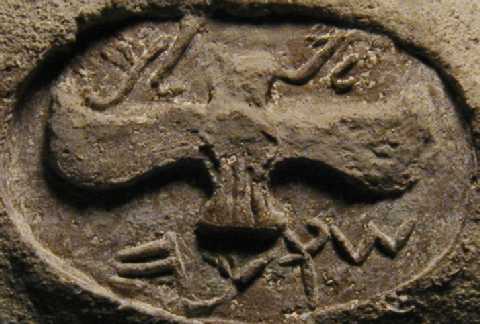
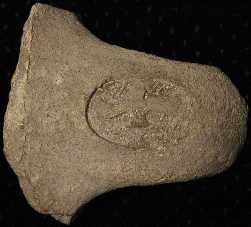
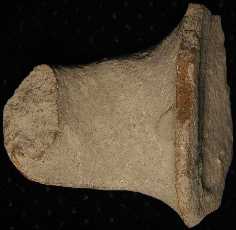
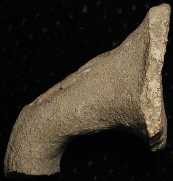
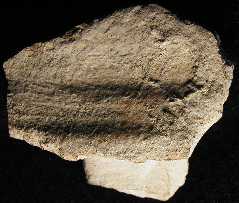
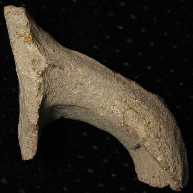 Description by Michael Welch: #95 One-third to one-half jar handle. Pottery color is orangish pinkish throughout the outside and core with white and black grits throughout. Bears an S2U impression. Out of LMLK on the top, around half of the initial Lamed remains, around three-fourths of the Mem remains, around seven-eighths of the second Lamed remains, and around three-fourths of the Kaph remains. Out of SUKH on the bottom, all of the Shin remains, all of the Waw remains, about three-fourths of the Kaph remains, and about two-thirds to three-fourths of the He remains. About three-fourths of the two-winged sun disc remains including most of the three rays of the sun on the bottom and good start of the sun orb in the center. The handle is covered in calcium carbonate and the dots after the Kaph and He may be there, but for now I cannot see them. From this handle and others we can see that the two-winged sun disc was patterned after King Hezekiah's two-winged sun disc seal found on several bullae during the last decade. This King's personal seal's bulla's central orb is not flat but is raised; the three rays of the sun on the bottom are longer, and the three rays on top are shorter. The main differences are the wings on the LMLK seals are upturned whereas Hezekiah's personal two-winged sun disc wings are downturned; and the size of the LMLK seals are around three times greater. Also on most two-winged sun disc LMLK seals there seems to be a hollowed out depth of a millimeter or two before the incised six rays of the sun start. Since most LMLK handles were not stamped deeply, only these two "triangular" platforms usually remain. The goal of the engravers--a clear six-rayed two-winged sun disc was seldom realized. It is also possible that there was a plume on each side of the central orb at the top of each wing. Perhaps the Nasbeh #2834 M2U example shows this. There is a finger indentation on the underside of the handle near where it connects to the jar pottery. This was probably made by the potter attaching the handle to the jar. There is a fresh chip near this area exposing the orangish core.
Description by Michael Welch: #95 One-third to one-half jar handle. Pottery color is orangish pinkish throughout the outside and core with white and black grits throughout. Bears an S2U impression. Out of LMLK on the top, around half of the initial Lamed remains, around three-fourths of the Mem remains, around seven-eighths of the second Lamed remains, and around three-fourths of the Kaph remains. Out of SUKH on the bottom, all of the Shin remains, all of the Waw remains, about three-fourths of the Kaph remains, and about two-thirds to three-fourths of the He remains. About three-fourths of the two-winged sun disc remains including most of the three rays of the sun on the bottom and good start of the sun orb in the center. The handle is covered in calcium carbonate and the dots after the Kaph and He may be there, but for now I cannot see them. From this handle and others we can see that the two-winged sun disc was patterned after King Hezekiah's two-winged sun disc seal found on several bullae during the last decade. This King's personal seal's bulla's central orb is not flat but is raised; the three rays of the sun on the bottom are longer, and the three rays on top are shorter. The main differences are the wings on the LMLK seals are upturned whereas Hezekiah's personal two-winged sun disc wings are downturned; and the size of the LMLK seals are around three times greater. Also on most two-winged sun disc LMLK seals there seems to be a hollowed out depth of a millimeter or two before the incised six rays of the sun start. Since most LMLK handles were not stamped deeply, only these two "triangular" platforms usually remain. The goal of the engravers--a clear six-rayed two-winged sun disc was seldom realized. It is also possible that there was a plume on each side of the central orb at the top of each wing. Perhaps the Nasbeh #2834 M2U example shows this. There is a finger indentation on the underside of the handle near where it connects to the jar pottery. This was probably made by the potter attaching the handle to the jar. There is a fresh chip near this area exposing the orangish core.
Formerly in the Gil Chaya collection (#Sochot; LMLK Dotcom ID# 053).
|








